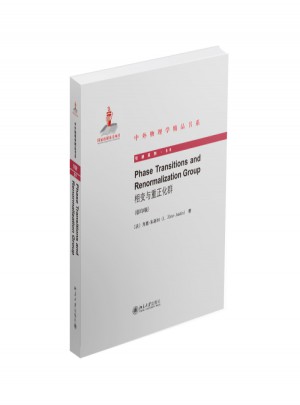

《相变与重正化群(英文影印版)》详细讨论了相变与重正化群的关系。特别是相变中的连续极限、相干长度及标度律等等。本书适合所有物理学领域的科研工作者和研究生阅读。
相变无疑是物理学中的重要的现象之一。对于相变的研究贯穿整个物理学,甚至是人类文明史。而现代物理学中,与相变息息相关的一个方法就是重正化群方法,其概念和思想已经渗透于物理学的各个领域。《相变与重正化群(英文影印版)》的引进,能够供所有物理学领域的工作者作为参考。
(法)齐恩-朱斯坦,法国原子研究中心教授。
1 Quantum field theory and the renormalization group.
1.1 Quantum electrodynamics: A quantum field theory.
1.2 Quantum electrodynamics: The problem of infinities
1.3 Renormalization.
1.4 Quantum field theory and the renormalization group
1.5 A triumph of QFT: The Standard Model
1.6 Critical phenomena: Other infinities
1.7 Kadanoff and Wilson`s renormalizationgroup
1.8 Effective quantum field theories
2 Gaussian expectation values. Steepest descent method
2.1 Generating functions
2.2 Gaussian expectation values.Wick`s theorem
2.3 Perturbed Gaussian measure. Connected contributions
2.4 Feynman diagrams. Connected contributions.
2.5 Expectation values. Generating function. Cumulants
2.6 Steepest descent method
2.7 Steepest descent method: Several variables, generating functions
Exercises
3 Universality and the continuum limit
3.1 Central limit theorem of probabilities
3.2 Universality and fixed points of transformations
3.3 Random walk and Brownian motion
3.4 Random walk: Additional remarks
3.5 Brownian motion and path integrals
Exercises
4 Classical statistical physics: One dimension
4.1 Nearest-neighbour interactions. Transfer matrix
4.2 Correlation functions
4.3 Thermodynamic limit
4.4 Connected functions and cluster properties
4.5 Statistical models: Simple examples
4.6 The Gaussian model924.7 Gaussian model: The continuumlimit
4.8 More general models: The continuumlimit
Exercises
5 Continuum limit and path integrals
5.1 Gaussian path integrals
5.2 Gaussian correlations.Wick`s theorem
5.3 Perturbed Gaussian measure
5.4 Perturbative calculations: Examples
Exercises
6 Ferromagic systems. Correlation functions
6.1 Ferromagic systems: Definition
6.2 Correlation functions. Fourier representation
6.3 Legendre transformation and vertex functions
6.4 Legendre transformation and steepest descent method
6.5 Two- and four-point vertex functions
Exercises145
7 Phase transitions: Generalities and examples
7.1 Infinite temperature or independent spins
7.2 Phase transitions in infinite dimension
7.3 Universality in infinite space dimension
7.4 Transformations, fixed points and universality
7.5 Finite-range interactions in finite dimension
7.6 Ising model: Transfer matrix
7.7 Continuous symmetries and transfer matrix
7.8 Continuous symmetries and Goldstone modes
Exercises
8 Quasi-Gaussian approximation: Universality, critical dimension.
8.1 Short-range two-spin interactions
8.2 The Gaussian model: Two-point function.
8.3 Gaussian model and random walk
8.4 Gaussian model and field integral
8.5 Quasi-Gaussian approximation
8.6 The two-point function: Universality
8.7 Quasi-Gaussian approximation and Landau`s theory
8.8 Continuous symmetries and Goldstone modes
8.9 Corrections to the quasi-Gaussian approximation
8.10 Mean-field approximation and corrections
8.11 Tricritical points
Exercises
9 Renormalization group: General formulation
9.1 Statistical field theory. Landau`s Hamiltonian
9.2 Connected correlation functions. Vertex functions
9.3 Renormalization group: General idea
9.4 Hamiltonian flow: Fixed points, stability
9.5 The Gaussian fixed point.2319.6 Eigen-perturbations: General analysis
9.7 A non-Gaussian fixed point: The ε-expansion
9.8 Eigenvalues and dimensions of local polynomials
10 Perturbative renormalization group: Explicit calculations.
10.1 Critical Hamiltonian and perturbative expansion
10.2 Feynman diagrams at one-loop order
10.3 Fixed point and critical behaviour
10.4 Critical domain
10.5 Models with O(N) orthogonal symmetry
10.6 Renormalization group near dimension 4
10.7 Universal quantities: Numerical results
11 Renormalization group: N-ponent fields
11.1 Renormalization group: General remarks
11.2 Gradient flow
11.3 Model with cubic anisotropy
11.4 Explicit general expressions: RG analysis
11.5 Exercise: General model with two parameters
Exercises
12 Statistical field theory: Perturbative expansion
12.1 Generating functionals
12.2 Gaussian field theory.Wick`s theorem
12.3 Perturbative expansion
12.4 Loop expansion
12.5 Dimensional continuation and regularization
Exercises
13 The σ4 field theory near dimension 4
13.1 Effective Hamiltonian. Renormalization
13.2 Renormalization group equations
13.3 Solution of RGE: The ε-expansion
13.4 Effective and renormalized interactions
13.5 The critical domain above Tc
14 The O(N) symmetric (φ2)2 field theory in the large N limit
14.1 Algebraic preliminaries
14.2 Integration over the field φ: The determinant
14.3 The limit N →∞: The critical domain
14.4 The (φ2)2 field theory for N →∞
14.5 Singular part of the free energy and equation of state
14.6 The λλ and φ2φ2 two-point functions
14.7 Renormalization group and corrections to scaling
14.8 The 1/N expansion
14.9 The exponent η at order 1/N
14.10 The non-linear σ-model
15 The non-linear σ-model
15.1 The non-linear σ-model on the lattice
15.2 Low-temperature expansion
15.3 Formal continuum limit
15.4 Regularization
15.5 Zero-momentum or IR divergences
15.6 Renormalization group
15.7 Solution of the RGE. Fixed points
15.8 Correlation functions: Scaling form
15.9 The critical domain: Critical exponents
15.10 Dimension 2
15.11 The (φ2)2 field theory at low temperature
16 Functional renormalization group
16.1 Partial field integration and effective Hamiltonian
16.2 High-momentum mode integration andRGE
16.3 Perturbative solution: φ4 theory
16.4 RGE: Standard form
16.5 Dimension 4
16.6 Fixed point: ε-expansion
16.7 Local stability of the fixed point
Appendix
A1 Technical results
A2 Fourier transformation: Decay and regularity
A3 Phase transitions: General remarks
A4 1/N expansion: Calculations
A5 Functional renormalization group: Complements
Bibliography
Index
很经典的相变图书
不错
图书有轻微损坏,无语
老师推荐的参考书